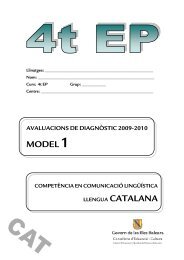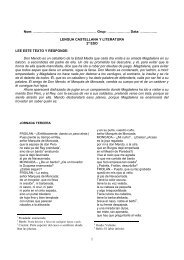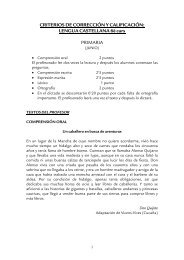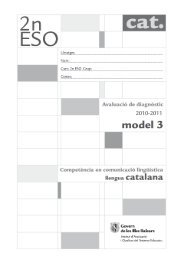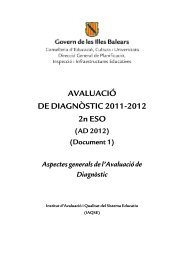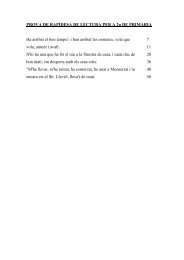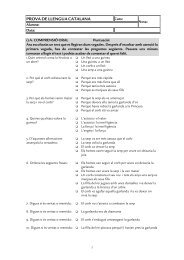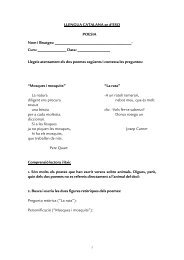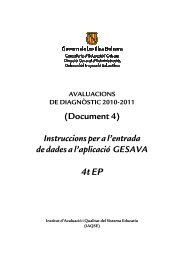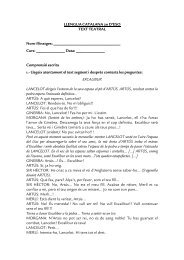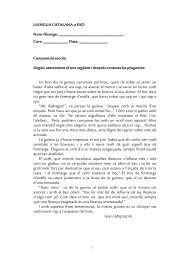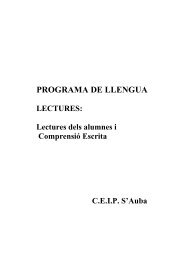Model 1 - Iaqse
Model 1 - Iaqse
Model 1 - Iaqse
Create successful ePaper yourself
Turn your PDF publications into a flip-book with our unique Google optimized e-Paper software.
ANG 2º ESO Mod1.indd 1 30/3/09 11:33:21
AVALUACIÓ DE DIAGNÒSTIC 2008-2009 2n ESO<br />
INSTRUCCIONS<br />
En aquesta prova escoltaràs primer un text i hauràs de contestar unes<br />
preguntes mentre l’escoltes. Després escoltaràs un segon text i a continuació<br />
contestaràs una sèrie de preguntes. En tercer lloc llegiràs una sèrie de textos i<br />
hauràs de respondre les preguntes que se’t facin. Pot ser que alguns apartats<br />
et resultin fàcils i altres més difícils. Recorda que has de llegir cada pregunta<br />
atentament.<br />
Et demanaran que responguis diferents tipus de preguntes. Algunes tendran<br />
quatre respostes possibles. Has d’escollir la correcta i encerclar la lletra que hi<br />
ha al costat. L’exemple 1 mostra aquest tipus de pregunta.<br />
Exemple 1<br />
How many months has a year?<br />
A. 2 months.<br />
B. 17 months.<br />
C. 12 months.<br />
D. 11 months.<br />
Si decideixes canviar la resposta a una pregunta, marca amb una X la teva<br />
primera tria i encercla després la resposta correcta, tal com es veu a l’exemple<br />
2, en el qual primer es va triar la resposta A i després la C.<br />
Exemple 2<br />
How many months has a year?<br />
A. 2 months.<br />
B. 17 months.<br />
C. 12 months.<br />
D. 11 months.<br />
2<br />
ANG 2º ESO Mod1.indd 2 30/3/09 11:33:24
MODEL 1 COMPETÈNCIA EN COMUNICACIÓ LINGÜÍSTICA EN LLENGUA ANGLESA<br />
En altres preguntes et demanaran que completis la resposta en l’espai<br />
assenyalat amb punts que hi ha al teu quadern. L’exemple 3 mostra aquest<br />
tipus de pregunta.<br />
Exemple 3<br />
Now write a note to your brother to leave him a message.<br />
……………………………………………………………………………………………<br />
……………………………………………………………………………………………<br />
RECORDA:<br />
Tens una hora per fer aquesta prova.<br />
Treballa de pressa sense perdre el temps.<br />
LISTENING COMPREHENSION 1<br />
Read the following questions first. Then listen to a conversation twice and<br />
answer the questions according to what you hear.<br />
PASSA LA PÀGINA I ESCOLTA ATENTAMENT!<br />
3<br />
ANG 2º ESO Mod1.indd 3 30/3/09 11:33:25
AVALUACIÓ DE DIAGNÒSTIC 2008-2009 2n ESO<br />
SITUATION: Pere is on holiday in London. He goes to a restaurant.<br />
1. What is the special dish of the day?<br />
A. Pizza.<br />
B. Hamburger.<br />
C. Fish and chips.<br />
D. Cheeseburger.<br />
2. What does Pere order?<br />
A. Fish and chips and coffee.<br />
B. A hamburger, chips and tea.<br />
C. A slice of pizza and a coke.<br />
D. A cheeseburger, chips and a coke.<br />
3. How much is the bill?<br />
A. £8’30<br />
B. £3’80<br />
C. £8’50<br />
D. £8’00<br />
4. What ice cream flavour does Pere ask for?<br />
A. Lemon.<br />
B. Vanilla.<br />
C. Strawberry.<br />
D. Chocolate.<br />
5. Write another ice-cream flavour that is in the menu (not the one that<br />
Pere asks for):<br />
………………......................................................………………….<br />
4<br />
ANG 2º ESO Mod1.indd 4 30/3/09 11:33:25
MODEL 1 COMPETÈNCIA EN COMUNICACIÓ LINGÜÍSTICA EN LLENGUA ANGLESA<br />
6. What meal of the day is it?<br />
A. Lunch.<br />
B. Dinner.<br />
C. Supper.<br />
D. Breakfast.<br />
7. What type of restaurant is Big Ben Café?<br />
A. A Chinese restaurant.<br />
B. A fast food restaurant.<br />
C. A vegetarian restaurant.<br />
D. A traditional Spanish restaurant.<br />
LISTENING COMPREHENSION 2<br />
Now you are going to listen to a text twice. Listen to it carefully and then<br />
read the questions and answer them according to the text you have heard.<br />
NO PASSIS LA PÀGINA FINS QUE NO SE T'INDIQUI!<br />
Escolta atentament!<br />
5<br />
ANG 2º ESO Mod1.indd 5 30/3/09 11:33:26
AVALUACIÓ DE DIAGNÒSTIC 2008-2009 2n ESO<br />
8. Who is talking?<br />
A. the pilot.<br />
B. a passenger.<br />
C. a ticket agent.<br />
D. an air-hostess.<br />
9. This is a flight…<br />
from ……………...…..……… to……………....…………….<br />
10.What’s the weather like in the destination?<br />
A. It’s stormy.<br />
B. It’s windy.<br />
C. It’s cold and raining.<br />
D. It’s hot and sunny.<br />
11.The estimated time of the flight is:<br />
A. 11 minutes.<br />
B. 35 minutes.<br />
C. 53 minutes.<br />
D. 3216 minutes.<br />
12.The speech takes place…<br />
A. on a ship.<br />
B. in a train.<br />
C. on a plane.<br />
D. in a car.<br />
6<br />
ANG 2º ESO Mod1.indd 6 30/3/09 11:33:27
MODEL 1 COMPETÈNCIA EN COMUNICACIÓ LINGÜÍSTICA EN LLENGUA ANGLESA<br />
READING COMPREHENSION 1<br />
Now, read the text carefully. Read the following text and circle the correct<br />
answer.<br />
7<br />
ANG 2º ESO Mod1.indd 7 30/3/09 11:33:27
AVALUACIÓ DE DIAGNÒSTIC 2008-2009 2n ESO<br />
The Olympic Games are an international multi-sports event. They take place every<br />
four years in a different country. The origin of the games is in the ancient Greece and<br />
the first modern Olympic Games took place in Athens in 1896.<br />
The last Olympic Games took place in Beijing (China) in 2008 and they were the 41 st<br />
games. The next games will be in 2012 in London and our country, Spain, has only<br />
organized the Olympics once; it was in Barcelona in 1992.<br />
Nowadays, there are 35 Olympic sports and 53 disciplines. In the last games in Beijing<br />
there were about 10.500 participants from 205 different countries.<br />
The most famous symbol of the Olympic Games is its flag. It has five Olympic Rings<br />
and each ring has a different colour. Each of the rings represents one continent and the<br />
colours are: red, blue, green, yellow, and black. Another important symbol is the<br />
Olympic Torch.<br />
SPORT CHARACTERISTICS EQUIPMENT<br />
Tennis<br />
Basketball<br />
Judo<br />
Athletics:<br />
marathon<br />
singles (2 players)<br />
doubles (4 players)<br />
two teams of 5<br />
players each<br />
Individual<br />
(there are different<br />
categories<br />
depending on the<br />
weight of the<br />
participants)<br />
Individual<br />
Distance: 42.195km<br />
balls<br />
racket<br />
net<br />
basketball<br />
basket<br />
backboard<br />
uniform<br />
(called<br />
“judogi”)<br />
running shoes<br />
8<br />
ORIGIN<br />
(modern<br />
sport)<br />
England<br />
19 th<br />
century<br />
USA<br />
19 th<br />
century<br />
Japan<br />
19 th<br />
century<br />
Ancient<br />
Greece<br />
490 BC<br />
GOLD MEDAL<br />
Beijing 2008<br />
Singles M:<br />
Rafel Nadal (Spain)<br />
Singles W:<br />
Elena Dementieva<br />
(Russia)<br />
M: USA team<br />
W: USA team<br />
M: Satoshi Ishii<br />
(Japan / +100 Kg.)<br />
W: Wen Tong<br />
(China / + 78 kg.)<br />
M: Tsegay Kebede<br />
(Ethiopia)<br />
W: Catherine<br />
Ndereba (Kenya)<br />
M = men<br />
W = women<br />
ANG 2º ESO Mod1.indd 8 30/3/09 11:33:29
MODEL 1 COMPETÈNCIA EN COMUNICACIÓ LINGÜÍSTICA EN LLENGUA ANGLESA<br />
13. Where were the Olympics born?<br />
A. In China.<br />
B. In Greece.<br />
C. In England.<br />
D. We don’t know.<br />
14. What number will the next games in London be?<br />
A. 40th<br />
B. 41st<br />
C. 42nd<br />
D. 43rd<br />
15. Apart from the Olympic Flag, name another symbol of the Olympic<br />
Games that appears in the text.<br />
.......................................................……....……….…………<br />
16. Say which of the sentences is FALSE:<br />
A. The Olympics last year took place in Asia.<br />
B. The next Olympics will take place in Europe.<br />
C. The Olympics have never taken place in Spain.<br />
D. The first modern Olympics took place in the 19th century.<br />
17. Complete:<br />
The Olympic flag has ……………… rings. Each ring has a<br />
different ………………………. and it represents the five<br />
……………………….. in the world. The colours of the flag are:<br />
yellow, ………………….., green, …………………….. and red.<br />
9<br />
ANG 2º ESO Mod1.indd 9 30/3/09 11:33:31
AVALUACIÓ DE DIAGNÒSTIC 2008-2009 2n ESO<br />
18. Which of these sports needs more than 2 participants?<br />
A. Tennis.<br />
B. Basketball.<br />
C. Judo.<br />
D. Marathon running.<br />
19. In which sport are the golden medallists from Africa?<br />
A. Tennis.<br />
B. Basketball.<br />
C. Judo.<br />
D. Marathon running.<br />
20. Which country won both men and woman gold medals in the same<br />
sport?<br />
A. The USA.<br />
B. Spain.<br />
C. Japan.<br />
D. Ethiopia.<br />
10<br />
ANG 2º ESO Mod1.indd 10 30/3/09 11:33:32
MODEL 1 COMPETÈNCIA EN COMUNICACIÓ LINGÜÍSTICA EN LLENGUA ANGLESA<br />
READING COMPREHENSION 2<br />
Now, read the text carefully. Read the following text and circle the correct<br />
answer.<br />
11<br />
ANG 2º ESO Mod1.indd 11 30/3/09 11:33:32
ANG 2º ESO Mod1.indd 12 30/3/09 11:33:34
MODEL 1 COMPETÈNCIA EN COMUNICACIÓ LINGÜÍSTICA EN LLENGUA ANGLESA<br />
22. What nationality is Aibo?<br />
…………………...............................................…..…<br />
23. When Aibo is happy…<br />
A. he barks.<br />
B. he moves his tail.<br />
C. he moves his ears.<br />
D. he sticks out his tongue.<br />
24. Tamagotchis are …………….. than Aibo.<br />
A. worse<br />
B. better<br />
C. gooder<br />
D. badder<br />
25. Aibo is better than Tamagotchi because…<br />
A. Aibo is cheaper.<br />
B. Tamagotchi bark.<br />
C. Aibo is more realistic.<br />
D. Tamagotchi is more modern.<br />
26. Which of the following sentences is TRUE?<br />
A. Aibo is very cheap.<br />
B. Aibo eats real food.<br />
C. Aibo wets the carpet.<br />
D. Aibo loves playing with toys.<br />
13<br />
ANG 2º ESO Mod1.indd 13 30/3/09 11:33:35
AVALUACIÓ DE DIAGNÒSTIC 2008-2009 2n ESO<br />
27. What can you use Aibo for?<br />
A. To clean the house.<br />
B. To prepare the food.<br />
C. To play with children.<br />
D. To answer the telephone.<br />
28. What animal does Aibo represent?<br />
A. A cat.<br />
B. A rabbit<br />
C. A dog<br />
D. A rat.<br />
WRITING<br />
29. What are they like? Write 5 sentences describing these two<br />
teenagers and then 5 sentences more comparing them. Can you see<br />
the differences?<br />
14<br />
ANG 2º ESO Mod1.indd 14 30/3/09 11:33:36
MODEL 1 COMPETÈNCIA EN COMUNICACIÓ LINGÜÍSTICA EN LLENGUA ANGLESA<br />
DESCRIPTION:<br />
1. .................................................................................................................<br />
2. .................................................................................................................<br />
3. .................................................................................................................<br />
4. .................................................................................................................<br />
5. .................................................................................................................<br />
COMPARISON:<br />
1. .................................................................................................................<br />
2. .................................................................................................................<br />
3. .................................................................................................................<br />
4. .................................................................................................................<br />
5. .................................................................................................................<br />
15<br />
ANG 2º ESO Mod1.indd 15 30/3/09 11:33:37<br />
29A<br />
29B<br />
29C<br />
29D<br />
29E
ANG 2º ESO Mod1.indd 16 30/3/09 11:33:37<br />
Dipòsit legal: PM-752-2009



